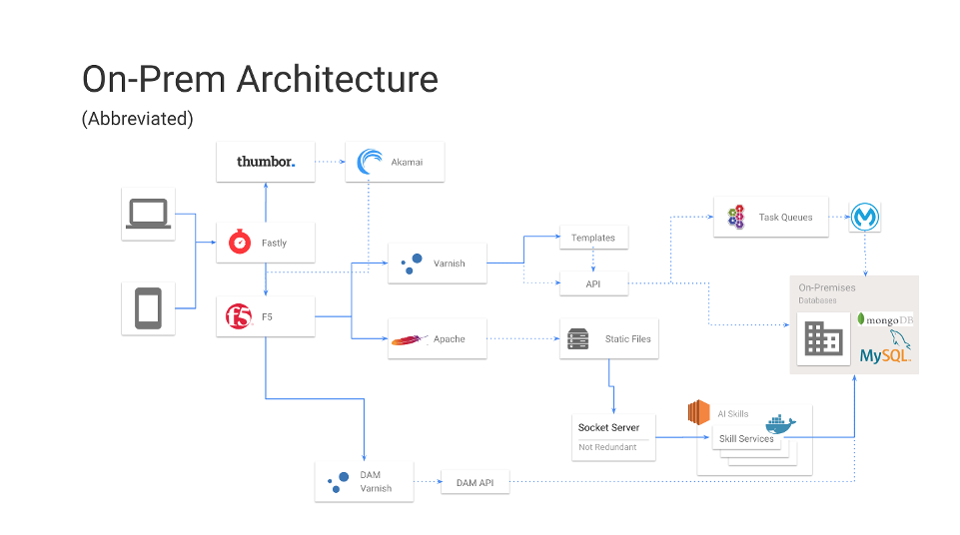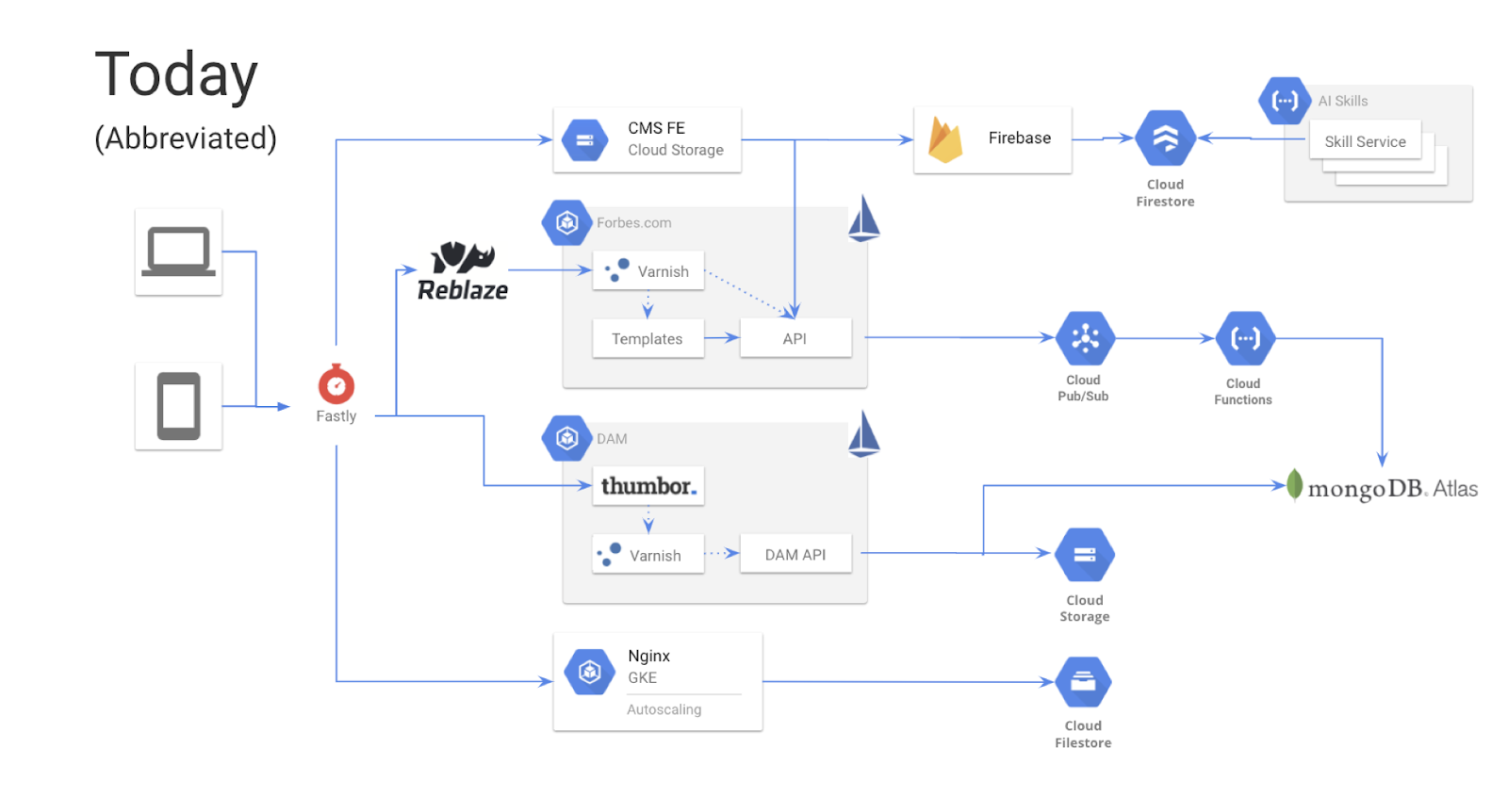Forbes: MongoDB Cloud Migration Helps World's Biggest Media Brand Continue To Set Standard For Digital Innovation
In 1996 Forbes launched its first website.
It was one of the first business publications in the world to do such an innovative thing. The original digital transformation.
In the 25 years since Forbes has only accelerated its efforts and is widely considered to set the standard for digital innovation in the publishing industry. The 100-year-old publisher, famous for its business journalism and rich-lists, has become the largest business media brand in the world. It reaches more than 140 million people worldwide every month, across a number of online and offline channels.
In just six months, Forbes migrated its platform to Google Cloud and MongoDB Atlas. Results include:
- 58% faster build time for new products and fixes
- Accelerated release cycle by 4x
- Reduced total cost of ownership by 25%
- 28% increase in subscriptions from new newsletters
During the pandemic the cloud infrastructure has also helped the website scale to an extraordinary number of users and helped the team stay nimble, introducing and testing a number of new features.

From June to December last year, traffic continued to grow - setting new records month after month. Then came COVID-19. Like many high-profile publications, Forbes' coverage of the pandemic has driven a further increase in traffic, reaching record traffic in May with more than 120 million unique visitors.
Despite the turmoil and unprecedented digital traffic it created, the development team continued to build, launch and test industry-leading features such as AI-assisted technology that recommend stories for its journalists and new data analysis tools to better understand reader behavior.
This ease of adaptation was powered by another change which had come just in time. At the end of 2019, Forbes finished the first stage of a comprehensive migration to the cloud. It included moving much of its transactional workload to MongoDB Atlas, the global cloud database service, and the Google Cloud.

We're very glad we moved to the cloud when we did. Shifting quickly to Google Cloud and MongoDB Atlas put us in a position to innovate and thrive even in the most difficult circumstances.
Vadim Supitskiy, Chief Technology Officer at Forbes
Rewritten Rules
The cloud migration was only the most recent step in Forbes’ 25-year digital transformation. A key element that helped the migration was a change made almost a decade ago. In 2011 the Forbes CMS (Content Management System) was completely re-written to enable a brand new contributor network strategy. The database they chose to build it on: a fledgling NoSQL database called MongoDB.
MongoDB’s document model meant developers could now build new features quickly, easily incorporate changes, and better handle a growing diversity of data types. The CMS was delivered in less than two months. The modernised architecture helped unlock new initiatives, including a massive network of new contributors and live social-media analysis which in turn improved engagement with Forbes' content.
Transformation Never Ends
The Forbes development team has always served three groups of important users: the readers, the journalists and the advertisers. All three appreciated the changes but they also had an insatiable appetite for better and different solutions. As years went by it became clear that Forbes would need to continue to adapt if it wanted to remain an industry leader. The company needed to further improve the user experience, expand the possibilities for journalists and deliver even better advertising collaborations. It couldn't deliver that efficiently with the existing architecture (see image 1).

So in 2018 Vadim and his team sketched out their vision: a cloud-native architecture which abstracted away almost all of the management of services. This would make it much easier to scale to handle large volumes of activity.It would also allow developers to build new awesome stuff and do it securely, quickly and with minimal overhead.
“We did not want to be in the database management business,” explained Vadim.
COVID and the Cloud
Jump ahead two years: February of 2020 and the COVID-19 pandemic is the biggest story of a generation and a crisis for almost every business. Forbes had not been idle in those intervening years. Vadim had insisted on an 'aggressive timeline'. The first stage of the cloud migration had already finished in late 2019 and had taken just six months to complete.
The centerpiece of which was a move to the cloud database service MongoDB Atlas, hosted on Google Cloud. But before they pushed everything live, they did something that not enough companies do: Test, test, test.
It was during that load testing and Quality Assurance (QA) phase that Forbes discovered a critical dependency: There was unacceptably high latency between the datacenter and the cloud. The round trip for data access would have been so slow that the resulting multiplier effect would have created a terrible user experience. To solve this they architected a phased rollout by breaking down the service transfer so that the core applications and databases all moved in one shot.
Once in place, the team used the new infrastructure to create an abstraction layer so that most services don't even directly touch the database. Instead Forbes makes use of an intermediate service, called the Content API. The API provides a stable API on top of the more fluid data structures hosted within MongoDB Atlas. This uncouples the format of the data from the requirements of the services using it. Services are no longer bound to the data schema. Make a change to one data structure in one place and it doesn’t break anything (or anyone) elsewhere in the stack.

Vadim explained: “We were now abstracted enough to focus solely on value delivery”. Developers no longer had to spend time on maintaining, managing and provisioning infrastructure.
The new infrastructure was immediately put to the test.
First, there was the scale. On top of record numbers in late 2019, the pandemic drove further increases in usage, reaching new record traffic with 121 million users in May. The website and the reader experience never wavered. Next, the business wanted to capitalize on the greater interest and roll out new customer-facing features. Freed to focus on value, the developers helped Forbes launch seven new newsletters which increased the subscription rate by 28%, a key business metric. There were also brand new Forums, new video products and a doubling in size of the breaking news team.
Machine Learning for Journalists
The combination of MongoDB Atlas within Google Cloud's native microservice architecture would also prove a wise choice. Firstly, Google Cloud’s Kubernetes Engine made it more manageable to orchestrate Forbes' horde of more than 50 microservices. (Focused, self-contained codebases that allow each service to be easily understood, modified quickly without dependencies on other services, and to be built with the best technology for the task.) Secondly, Atlas was also able to work seamlessly with Google Cloud's suite of services to build even more powerful tools for its writers.
In April, Forbes introduced a trending story recommendation engine for journalists. The engine scrapes the internet for trending stories and uses Google Cloud's machine learning to make suggestions to appropriate contributors, either through a Slack bot or through the custom CMS (the CMS itself had been rewritten again in 2019 to become more of an AI and analytics driven platform) . Like everything at Forbes the engine is still undergoing heavy testing but it has proved instantly helpful to Forbes’ editorial team and contributor network.
Entrepreneurial Developers
The Forbes development team is as entrepreneurial as the people that grace its magazine covers or homepage. They know cloud migrations and innovations are only as great as the business results they generate.
Forbes' cloud migration led to a 58% improvement in build speed and the release cycle has improved 2x to 10x (depending on the service). Other efficiencies that came with the migration resulted in a 25% reduction in total cost of ownership.
Forbes is already looking ahead to the next era of publishing. The new cloud infrastructure will be immediately tasked with enabling improved personalization, loyalty and managing first party data.
“Digital transformation is never finished,” Vadim points out. Considering they’re 25 years into this, it's hard to disagree.